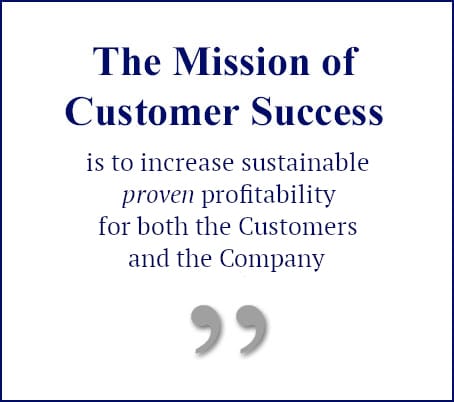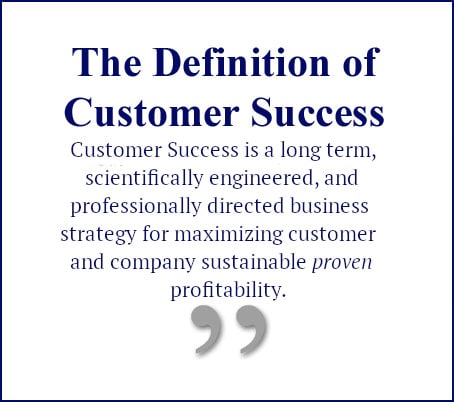Career Pathing in Customer Success (CS) is important for individuals and for companies. Staying with a company for two to five years is completely acceptable these days. In Silicon Valley, I see people staying less than 18 months and no one blinks. The Customer Success Association research data indicates that the turnover rate for CS executives can be over 60% over 2 years. The fight for talent is real and if you are good, you want to be compensated well and constantly growing. Don’t believe me? The Washington Post recently reported that 71% of employees are either seeking a new job or showing up at work disengaged. If individuals don’t have opportunities to constantly grow, learn and be challenged, they will leave for a new job where they may be getting paid only slightly more but where they have more gateways for growth and stimulation.
 In my career, I left more than one company that I loved being part of but where I no longer had a place to grow as a leader – a pathway I was determined to explore and grow into. I tried everything from speaking to my boss, to the CEO, and to other leaders in the organization to identify new opportunities where I could lead a team while also giving back as a valuable asset with deep product and customer knowledge. Career pathing is important for anyone at any level – whether you have a C -Title or are just starting out your career in Customer Success. Other factors include the maturity of your company and of the customer success team, and what actual opportunities are open.
In my career, I left more than one company that I loved being part of but where I no longer had a place to grow as a leader – a pathway I was determined to explore and grow into. I tried everything from speaking to my boss, to the CEO, and to other leaders in the organization to identify new opportunities where I could lead a team while also giving back as a valuable asset with deep product and customer knowledge. Career pathing is important for anyone at any level – whether you have a C -Title or are just starting out your career in Customer Success. Other factors include the maturity of your company and of the customer success team, and what actual opportunities are open.
 Career-Pathing doesn’t mean everyone wants to move up some corporate ladder and move into leadership. Some customer success managers (CSMs), don’t want to manage people as well as customers. Instead, for example, they may be interested in moving from ‘small’ to ‘enterprise’ to ‘strategic’ customer management roles. Others are content in the same role for extended periods and then want to move to another department to explore a completely new role. It doesn’t mean they are not ambitious. It means they are good at what they do, they have found a career that fits their career desires and lifestyle, yet they are seeking new ways to grow – not necessarily in a management capacity. Regardless of what path CSMs take, it is safe to say most want to be challenged, constantly be learning and getting better at their craft. When companies don’t offer pathways, they find themselves losing valuable employees after a mere year, when they just finished fully ramping up the employee. They also risk losing customer knowledge, and trusted relationships the CSM has built. It doesn’t have to be this.
Career-Pathing doesn’t mean everyone wants to move up some corporate ladder and move into leadership. Some customer success managers (CSMs), don’t want to manage people as well as customers. Instead, for example, they may be interested in moving from ‘small’ to ‘enterprise’ to ‘strategic’ customer management roles. Others are content in the same role for extended periods and then want to move to another department to explore a completely new role. It doesn’t mean they are not ambitious. It means they are good at what they do, they have found a career that fits their career desires and lifestyle, yet they are seeking new ways to grow – not necessarily in a management capacity. Regardless of what path CSMs take, it is safe to say most want to be challenged, constantly be learning and getting better at their craft. When companies don’t offer pathways, they find themselves losing valuable employees after a mere year, when they just finished fully ramping up the employee. They also risk losing customer knowledge, and trusted relationships the CSM has built. It doesn’t have to be this.
Here are three steps you can take to ensure your employees are growing with your company for mutually long-term success.
1. Start Career-Path Planning Early.
Career-pathing doesn’t have to be time-consuming to or overly defined to start. There are some online graphs to show the growth trajectory in customer success in different stage companies, from start-up where a CSM does everything from support to renewals, to public companies where a CSM may have a very prescriptive role with one or two customers in their portfolio.
2. Publicly share the growth opportunities within the organization.
 With Intranets, google docs, and employee engagement sites as a norm, it should be easy to share the career path opportunities in an organization. The roles should be clearly explained, including the prerequisites and requirements for success. When I hire people in any role, I ask them if they are willing to commit to a year of learning and serving in that role. If the person can’t look at you in the eye and tell you they are signing up for the job, title, salary, equity and challenge for a minimum of one year, then they are probably applying to the wrong role and you may reconsider the offer. This is important because when employees come to me a few months after starting and tell me they are bored and want a promotion or to move to another department altogether because they actually want to be in sales, it can lead to frustration on all sides of the table.
With Intranets, google docs, and employee engagement sites as a norm, it should be easy to share the career path opportunities in an organization. The roles should be clearly explained, including the prerequisites and requirements for success. When I hire people in any role, I ask them if they are willing to commit to a year of learning and serving in that role. If the person can’t look at you in the eye and tell you they are signing up for the job, title, salary, equity and challenge for a minimum of one year, then they are probably applying to the wrong role and you may reconsider the offer. This is important because when employees come to me a few months after starting and tell me they are bored and want a promotion or to move to another department altogether because they actually want to be in sales, it can lead to frustration on all sides of the table.
Career-pathing and promotions aren’t the same things. Often promotions show an employee has increased his/her skills, they have built trust and they are now being given additional responsibility. This of course, usually results in additional compensation, equity, and public recognition. What is the result of this public praise? Some argue that promotions lead to more hierarchy, which doesn’t necessarily result in a better work culture, more productivity or higher quality work. You want to be careful how career progression impacts the company overall and how you want to announce it at your company. How do you ensure career pathing is a positive experience for everyone? Create transparent career paths that anyone can access. Explain the title, salary range, required skills, and role expectations.
3. Don’t move poor performers to other roles and/or other departments.
 Sometimes managers don’t have a place to move an employee or the employee isn’t performing well and is seeking a way to stay within the company but in a different capacity. When you move one problem or unhappy employee from one role to another, don’t assume the move will fix any issues that have arisen in their current role. You are doing the organization and the employee a disservice by moving them, hoping the problem will go away. You need to address the performance issue and agree to improvements first. In one company I worked at, employees had to perform and meet their quarterly goals, successfully for at least one year before they could be considered for a change or promotion (with rare exceptions). I like this approach because it ensures mediocre employees aren’t passed around until someone finally has the courage to fire the employee. While this may not be seen as a means to career pathing, it is sometimes necessary for the well being of the company, your team and for the employee. Explain to them why you are ending the business relationship and offer to support them in their next endeavors. I have had employees come back to me and thank me for helping them realize customer success wasn’t their calling and now they are in roles that they are passionate about and thriving in.
Sometimes managers don’t have a place to move an employee or the employee isn’t performing well and is seeking a way to stay within the company but in a different capacity. When you move one problem or unhappy employee from one role to another, don’t assume the move will fix any issues that have arisen in their current role. You are doing the organization and the employee a disservice by moving them, hoping the problem will go away. You need to address the performance issue and agree to improvements first. In one company I worked at, employees had to perform and meet their quarterly goals, successfully for at least one year before they could be considered for a change or promotion (with rare exceptions). I like this approach because it ensures mediocre employees aren’t passed around until someone finally has the courage to fire the employee. While this may not be seen as a means to career pathing, it is sometimes necessary for the well being of the company, your team and for the employee. Explain to them why you are ending the business relationship and offer to support them in their next endeavors. I have had employees come back to me and thank me for helping them realize customer success wasn’t their calling and now they are in roles that they are passionate about and thriving in.
From the Beginning
 Career pathing starts with conversations with employees on your team. When you hire someone, ask them where they want to be in a year, in three years, in five years. If you inherit a team, interview your direct reports and ask them the same things. Then ask them to do the same with their direct reports – to learn about what their team members aspire to, which path is most interesting to them in a year from now, and how they can make your organization better. This will help you create transparent career paths, help you better understand your team and their skills, where there are gaps, and what you need to do as a leader to keep your team engaged in the next few months and years. If you aren’t challenging employees, no matter what level they are at, then they will become disengaged, potentially leading to poor customer experiences and then a departure from the company. Not everyone knows that they want to do, be when they grow out of a job. You need to challenge your team constantly in a way that will inspire them as they refine their customer leadership skills and either grows with your company or leaves.
Career pathing starts with conversations with employees on your team. When you hire someone, ask them where they want to be in a year, in three years, in five years. If you inherit a team, interview your direct reports and ask them the same things. Then ask them to do the same with their direct reports – to learn about what their team members aspire to, which path is most interesting to them in a year from now, and how they can make your organization better. This will help you create transparent career paths, help you better understand your team and their skills, where there are gaps, and what you need to do as a leader to keep your team engaged in the next few months and years. If you aren’t challenging employees, no matter what level they are at, then they will become disengaged, potentially leading to poor customer experiences and then a departure from the company. Not everyone knows that they want to do, be when they grow out of a job. You need to challenge your team constantly in a way that will inspire them as they refine their customer leadership skills and either grows with your company or leaves.
Emilia D’Anzica
 Emilia D’Anzica, MBA, PMP is the founder and CEO of Growth Molecules, a consulting firm focused on developing customer-centric programs that transform businesses & individuals. Services include advising companies on customer growth, building customer success playbooks and journeys, and organizational design. She is an executive coach, a frequent writer, and educator on scaling saas teams and growing customer accounts. Emilia holds an MBA from St. Mary’s College of California, and is based in the Bay Area.
Emilia D’Anzica, MBA, PMP is the founder and CEO of Growth Molecules, a consulting firm focused on developing customer-centric programs that transform businesses & individuals. Services include advising companies on customer growth, building customer success playbooks and journeys, and organizational design. She is an executive coach, a frequent writer, and educator on scaling saas teams and growing customer accounts. Emilia holds an MBA from St. Mary’s College of California, and is based in the Bay Area.









